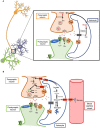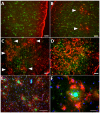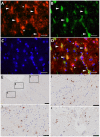Deciphering the Astrocyte Reaction in Alzheimer's Disease
- PMID: 29922147
- PMCID: PMC5996928
- DOI: 10.3389/fnagi.2018.00114
Deciphering the Astrocyte Reaction in Alzheimer's Disease
Abstract
Reactive astrocytes were identified as a component of senile amyloid plaques in the cortex of Alzheimer's disease (AD) patients several decades ago. However, their role in AD pathophysiology has remained elusive ever since, in part owing to the extrapolation of the literature from primary astrocyte cultures and acute brain injury models to a chronic neurodegenerative scenario. Recent accumulating evidence supports the idea that reactive astrocytes in AD acquire neurotoxic properties, likely due to both a gain of toxic function and a loss of their neurotrophic effects. However, the diversity and complexity of this glial cell is only beginning to be unveiled, anticipating that astrocyte reaction might be heterogeneous as well. Herein we review the evidence from mouse models of AD and human neuropathological studies and attempt to decipher the main conundrums that astrocytes pose to our understanding of AD development and progression. We discuss the morphological features that characterize astrocyte reaction in the AD brain, the consequences of astrocyte reaction for both astrocyte biology and AD pathological hallmarks, and the molecular pathways that have been implicated in this reaction.
Keywords: Alzheimer’s disease; amyloid plaques; astrocytes; glia; microglia; neurofibrillary tangles.
Figures





Similar articles
-
All roads lead to heterogeneity: The complex involvement of astrocytes and microglia in the pathogenesis of Alzheimer's disease.Front Cell Neurosci. 2022 Aug 12;16:932572. doi: 10.3389/fncel.2022.932572. eCollection 2022. Front Cell Neurosci. 2022. PMID: 36035256 Free PMC article. Review.
-
The Role of Glial Cells and Synapse Loss in Mouse Models of Alzheimer's Disease.Front Cell Neurosci. 2018 Dec 11;12:473. doi: 10.3389/fncel.2018.00473. eCollection 2018. Front Cell Neurosci. 2018. PMID: 30618627 Free PMC article. Review.
-
Amyloid-β induced astrocytosis and astrocyte death: Implication of FoxO3a-Bim-caspase3 death signaling.Mol Cell Neurosci. 2015 Sep;68:203-11. doi: 10.1016/j.mcn.2015.08.002. Epub 2015 Aug 8. Mol Cell Neurosci. 2015. PMID: 26260111
-
Elucidating the Interactive Roles of Glia in Alzheimer's Disease Using Established and Newly Developed Experimental Models.Front Neurol. 2018 Sep 26;9:797. doi: 10.3389/fneur.2018.00797. eCollection 2018. Front Neurol. 2018. PMID: 30319529 Free PMC article. Review.
-
Application of triple immunohistochemistry to characterize amyloid plaque-associated inflammation in brains with Alzheimer's disease.Biotech Histochem. 2001 Mar;76(2):97-106. Biotech Histochem. 2001. PMID: 11440311
Cited by
-
Glaucoma: from pathogenic mechanisms to retinal glial cell response to damage.Front Cell Neurosci. 2024 Jan 25;18:1354569. doi: 10.3389/fncel.2024.1354569. eCollection 2024. Front Cell Neurosci. 2024. PMID: 38333055 Free PMC article. Review.
-
Critical Molecular and Cellular Contributors to Tau Pathology.Biomedicines. 2021 Feb 14;9(2):190. doi: 10.3390/biomedicines9020190. Biomedicines. 2021. PMID: 33672982 Free PMC article. Review.
-
Human iPSC-Derived Neural Models for Studying Alzheimer's Disease: from Neural Stem Cells to Cerebral Organoids.Stem Cell Rev Rep. 2022 Feb;18(2):792-820. doi: 10.1007/s12015-021-10254-3. Epub 2022 Feb 2. Stem Cell Rev Rep. 2022. PMID: 35107767 Free PMC article. Review.
-
Enhanced delivery of a low dose of aducanumab via FUS in 5×FAD mice, an AD model.Transl Neurodegener. 2022 Dec 27;11(1):57. doi: 10.1186/s40035-022-00333-x. Transl Neurodegener. 2022. PMID: 36575534 Free PMC article.
-
Astrocytic MicroRNAs and Transcription Factors in Alzheimer's Disease and Therapeutic Interventions.Cells. 2022 Dec 17;11(24):4111. doi: 10.3390/cells11244111. Cells. 2022. PMID: 36552875 Free PMC article. Review.
References
-
- Akiyama H., Mori H., Saido T., Kondo H., Ikeda K., McGeer P. L. (1999). Occurrence of the diffuse amyloid β-protein (Aβ) deposits with numerous Aβ-containing glial cells in the cerebral cortex of patients with Alzheimer’s disease. Glia 25, 324–331. 10.1002/(sici)1098-1136(19990215)25:4<324::aid-glia2>3.0.co;2-5 - DOI - PubMed
-
- Alcolea D., Vilaplana E., Pegueroles J., Montal V., Sánchez-Juan P., González-Suárez A., et al. . (2015). Relationship between cortical thickness and cerebrospinal fluid YKL-40 in predementia stages of Alzheimer’s disease. Neurobiol. Aging 36, 2018–2023. 10.1016/j.neurobiolaging.2015.03.001 - DOI - PubMed
Publication types
Grants and funding
LinkOut - more resources
Full Text Sources
Other Literature Sources

